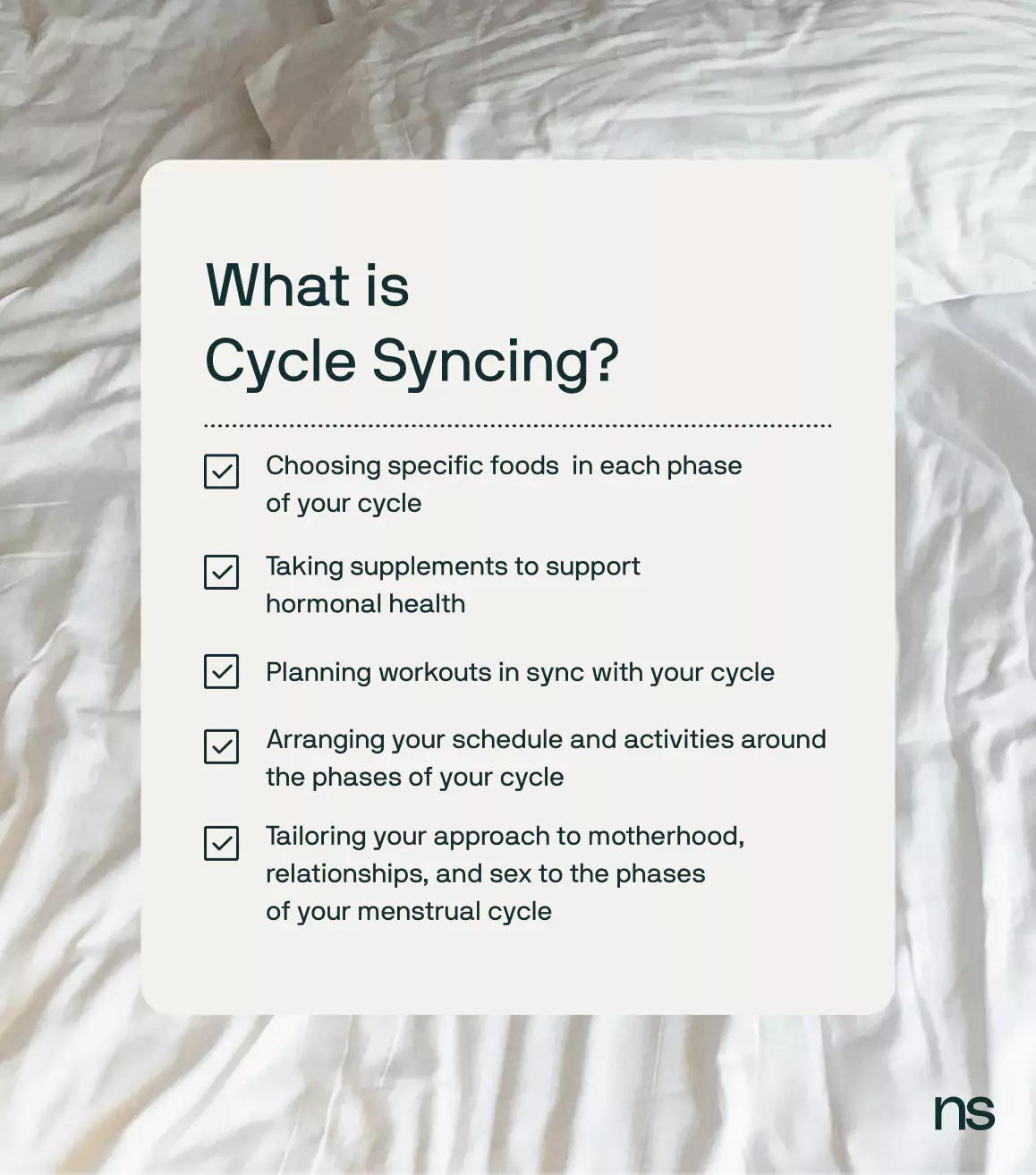Cycle Syncing: Everything You Need to Know

Key Takeways
What if there was a new way to balance your hormones and reduce some of the side effects that come with menstruation? When it comes to women’s health, the menstrual cycle can have a bigger impact on daily life than you may realize.
This is where cycle syncing comes in. The premise of cycle syncing involves tailoring your workouts and dietary habits according to where you are in your menstrual cycle.
Many of the changes in mood, skin, sex drive, and energy levels that occur through the month are due to the hormonal shifts that take place during the menstrual cycle. Can doing certain activities at specific times of the month really help you feel more energized, have fewer mood swings, and more effective workouts?
By the end of this article, you’ll know about the basics of an idea called cycle syncing and why some people believe that this lifestyle can improve your wellbeing.
The Menstrual Cycle Phases
.webp)
As we shared in our article on period weight gain, your body has two main menstrual phases called the follicular phase and the luteal phase. The ovulatory phase falls right in between these two phases, and lasts only about 24 hours.
Estrogen, progesterone, luteinizing hormone, and follicular stimulating hormone are just a few of the hormones involved in your menstrual cycle. During menstruation, your body sheds its uterine lining.
This occurs at the beginning of your menstrual cycle. The length of the menstrual cycle is usually between 25 and 30 days, but it may be longer or shorter for some people.
What is the Cycle Syncing Philosophy?

Cycle syncing is a term coined and trademarked by Alisa Vitti, Functional Nutritionist, HHC, AADP in her book Womancode. According to Alissa, cycle syncing is the process of aligning our lifestyle with the specific phase of our menstrual cycle.
It begins with familiarizing yourself with the different phases of your menstrual and hormonal cycle, then tailoring your diet, physical activity, supplement intake, and lifestyle choices to the strengths, weaknesses, and needs of each phase of your cycle.
Cycle syncing involves:
- Choosing specific foods to support hormonal balance in each phase of your cycle
- Taking supplements to support hormonal health and combat hormonal symptoms like PMS, acne, bloating, and fatigue
- Planning cardio, strength training, and HIIT workouts in sync with your cycle
- Planning your schedule and activities around the phases of your cycle
- Tailoring your approach to motherhood, relationships, and sex to the phases of your menstrual cycle
Cycle Syncing Science: Is There Enough Evidence?
Cycle syncing is said to improve your hormonal balance, helping you feel more energized, experience fewer mood swings, have more effective workouts, and even help with conception. However, cycle syncing is a very new concept, so research about the effectiveness of this method is still ongoing and very limited.
While we know that diet and lifestyle factors do impact hormone levels and menstrual symptoms such as PMS, there’s not yet enough evidence from high-quality randomized controlled trials to suggest specific cycle syncing protocols.
Individual responses to foods, exercise, and lifestyle changes can vary greatly. Similarly, the menstrual cycle is not the same for everyone. For example, people with conditions like PCOS and endometriosis may experience irregular cycles.
Cycle Syncing Workouts
The research on cycle syncing workouts in particular is lacking. Tailoring your workouts to your specific menstrual cycle phase is proposed by some to help support improved hormone balance. This, they say, can lead to reduced negative hormone-related symptoms through the month such as fatigue and mood swings.
There is some evidence suggesting that certain phases of your menstrual cycle may be optimal for different types of exercise. Unfortunately, there’s currently no evidence showing cycle syncing has any significant benefits.
The Impact of Hormones: What We Know

While research does not yet necessarily back up the cycle syncing method at this time, scientists do know that your hormones can impact different bodily functions. Here are a few of the ways that your menstrual hormones may impact you.
Hormones and Brain Function
The hormones that control the menstrual cycle may have an influence on several areas of brain function, including cognition, emotional status, sensory processing, and appetite. Studies show that estrogen can influence the hypothalamus and the hippocampus in the brain.
These are involved in emotions, perception, memory, and the processing of sensory information. Estrogen also influences the brainstem and neocortex, which are involved in motor function, language, emotional and sensory information, and consciousness.
Menopause, which signals the end of your menstrual cycle, is often accompanied by changes in these cognitive functions as a result of changing estrogen levels.
Hormones and Exercise

Studies show that hormones may also have an impact on exercise performance, particularly during the early follicular phase. This may be due to the effects of estrogen, which has a role in building muscle, regulating substrate metabolism, influencing inflammation, and may have neuroexcitatory effects.
When estrogen rises, it may affect our muscles and exercise performance, especially in high-intensity workouts. However, more high-quality research and evidence is needed to confirm these findings and establish a connection.
Changes in sex hormone levels may also influence how our bodies use different nutrients during exercise. These hormones may mediate some aspects of carbohydrate and fat metabolism during different phases in the menstrual cycle, and our metabolism of these nutrients greatly affects our ability to produce energy during exercise.
More research is needed to determine exactly how our hormones influence our metabolism and energy production, and whether or not this affects a significant portion of the menstruating population.
Hormones and Blood Pressure
Sex hormones may have an impact on blood pressure. One study had 30 women with normal blood pressure and 10 women with mild hypertension measure their blood pressure every morning for six weeks.
All the women in the study had regular menstrual cycles and entered the study at different phases in their cycle. Researchers found that participants’ blood pressure tended to be higher at the onset of menstruation than at most other phases of their cycle.
In this study, blood pressure was also higher in the follicular phase, when estrogen levels increase, than in the luteal phase, when estrogen levels decrease.
Hormones and Cravings

Having your period may be associated with increased food cravings for good reason. Studies show that people in the premenstrual phase crave more carbohydrates, particular people who experience PMS.
This may be due to fluctuations in your body’s energy intake during different phases of the menstrual cycle. One study found that, during the luteal phase, women with higher estradiol reported consuming more carbohydrate-rich foods.
Women with higher progesterone during the luteal phase reported increased cravings for sugary beverages.
Changes in basal metabolic rate throughout the menstrual cycle also take place. Some studies show that metabolic rate (and caloric needs) may increase in the luteal phase, perhaps impacting cravings.
Hormones and Energy Levels
Some phases of the menstrual cycle are commonly associated with fatigue. A recent 2020 study compared self-reported physical and mental fatigue in the early-follicular and mid-luteal phases of 18 women with generalized anxiety disorder (GAD) and 20 women without anxiety.
Researchers found that mental fatigue in the non-anxious group increased to levels experienced by the GAD group during the mid-luteal phase, when they experience a higher level of estrogen and progesterone.
Hormones and Sleep
The hormones involved in your menstrual cycle may affect your quality of sleep. One study of 579 menstruating women found that an irregular menstrual cycle with heavier bleeding was associated with shorter sleep duration, poor sleep quality, fatigue, stress, and depression.
Interestingly, a hormonal imbalance is a possible cause of irregular, heavy bleeding during the menstrual cycle.
What Can You Do? 4 Tips to Help You Get Started

Exploring the unique connections between your menstrual cycle, PMS symptoms, food, exercise, and other lifestyle factors can be a valuable experience. Unfortunately, since the research around the benefits of cycle syncing is still so limited, it may not yet be possible to recommend a specific cycle syncing protocol to everyone across the board.
However, there is still a lot you can do to align your food choices, exercise, and lifestyle with your body for menstrual cycle support. Here's how to get started with tracking your cycle.
1) Track Your Cycles
Tracking your cycle is a great way to get a sense of when the phases of your unique cycle occur and keep track of any changes or irregularities in your cycle, like heavy bleeding, severe cramps, PMS, or anything else. There are many popular period tracking apps on the market today that can make this process fun and easy.
Flo, available for Apple and Android, is one example that includes a cycle and period tracker, an ovulation calculator, and a pregnancy calendar. Flo does not share your data with any other companies.
This popular app also has an anonymous mode, which allows you to keep track of your cycle without any tie to your email, personal info, or identity.
2) Minimize Your Stress

There is some evidence to suggest that stress can affect our sex hormones. Research shows that stress can impair normal ovarian processes through activation of the hypothalamic-pituitary-adrenal axis.
This axis is a complex system that regulates many physiological processes, including immune responses, the autonomic nervous system, reproductive hormones and fertility.
Stress can affect the regularity of our cycles, even beyond the particular cycle in which the stress occurs. Read our article on 13 tips for relieving stress.
3) Track Your Blood Sugar
Sex hormones like estrogen and progesterone may play a role in energy metabolism, insulin sensitivity, and glucose metabolism.
Generally, estrogen seems to promote insulin sensitivity while progesterone may promote insulin resistance. Insulin sensitivity is higher during the follicular phase and decreases in the luteal phase.
Using a continuous glucose monitor can be a great way to monitor your blood sugar during your cycle. A CGM automatically tracks your blood sugar levels in real-time, meaning you can see your blood sugar level at any time and even track how it responds to food and exercise.
4) Work With A Nutritionist Specializing in Hormonal Health

Your body is unique, so it may be worth your while to explore a customized approach to your reproductive health. Sticking to a diet favoring complex carbohydrates over processed or refined carbs, lean protein sources from whole foods, and healthy fats is a great place to start.
Here are a few foods to try adding to your diet:
- Carbs like quinoa, brown rice, sweet potatoes, and whole grain bread
- Colorful veggies and leafy greens
- Protein sources like lean chicken, fatty fish, or tofu
- Healthy fats from foods such as avocados, pumpkin seeds, chia seeds, salmon, and olive oil
Teaming up with a registered dietitian who specializes in reproductive or hormonal health can give you a personalized support system and help you experiment with different dietary approaches throughout your cycle.
Find the right Nutrisense programto turn insight into progress.
Go Beyond Glucose Data with Nutrisense
Your glucose can significantly impact how your body feels and functions. That’s why stable levels are an important factor in supporting overall wellbeing. But viewing glucose isn't enough. Nutrisense, you’ll be able to learn how to use your body's data to make informed lifestyle choices that support healthy living.
One-to-one coaching
Sign up to access insurance-covered video calls to work with a glucose expert: a personal registered dietitian or certified nutritionist who will help tailor your lifestyle and diet to your goals.
Monitor and measure what matters
With the Nutrisense CGM Program, you can monitor your glucose with health tech like glucose biosensors and continuous glucose monitor (CGM)s, and analyze the trends over time with the Nutrisense App. This will help you make the most informed choices about the foods you consume and their impact on your health.
Find your best fit
Ready to take the first step? Start with our quiz to find the right Nutrisense program to help you take control.

Heather is a Registered and Licensed Dietitian Nutritionist (RDN, LDN), subject matter expert, and technical writer, with a master's degree in nutrition science from Bastyr University. She has a specialty in neuroendocrinology and has been working in the field of nutrition—including nutrition research, education, medical writing, and clinical integrative and functional nutrition—for over 15 years.




